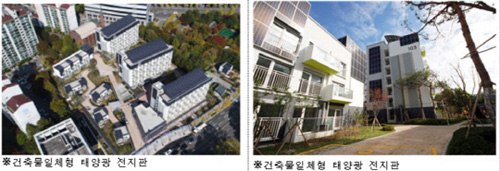‘Zero energy’ apartment house to be constructed in Nowon district… Heating & cooling system without fossil fuel
[ Park Sang Gil sweatsk@ ] | 2017-12-08 10:35:48
A bird's-eye view of a zero-energy apartment with a solar module. Photo by Ministry of Land, Transport and Maritime
The Ministry of Land, Infrastructure and Transport (R & D) has been promoted as a national R & D project to cope with climate change problems. The first zero-energy apartment house in Korea was built by participating in the Seoul City, Nowon-gu, Myongji University Industry Collaboration Team (Myongji University, KCC) It is a demonstration complex. It can be used for heating and cooling, hot water, lighting, ventilation without using fossil fuel.
Zero energy apartment houses were constructed with rental housing complexes of 121 ~ 121㎡ with 39 ~ 59㎡ of exclusive area such as apartments, annexed houses and single houses. The Ministry of Land, Infrastructure and Transport has invested KRW 49.3 billion in its goal of zeroing energy costs including cooling and heating, hot water supply, lighting and ventilation. The Ministry of Land, Infrastructure and Transport plans to verify the feasibility of the zero-energy housing supply target in 2025 through the Zero Energy Demonstration Complex.
This house is able to maintain a comfortable living environment with less energy using passive design technology for insulation and air-tightness. Especially, energy costs are reduced by using renewable energy such as photovoltaic and geothermal systems. By using passive design technology that maximizes the insulation performance such as outer insulation, high air tight structure, triple roy glass, and external blind inside and outside the house, 61% of energy was saved and utilization of high efficient facilities such as heat recovery type ventilation device and optimum control facility 3% additional energy savings.
It produces 33% energy through renewable energy technologies such as solar panel and geothermal heat pump. As a result, 7% of the remaining energy is generated, and the residents can perform basic residential activities such as heating, cooling, hot water supply, lighting and ventilation without using fossil fuel.
Meanwhile, each household can save about KRW 9,700 per year in heating, cooling, hot water, lighting, and ventilation compared to 2009 houses of the same size through zero energy technology. Residents are expected to pay about KRW 27,000 per month for electrical energy for cooking, household appliances, public areas such as parking lots and elevators in each household.
"All households will be provided with rented housing, which will serve as a stepping stone to the newlyweds and other residents," a ministry official said. "It is supplied by 100 newlyweds, 12 elderly people, cooperative furniture, and monitoring furniture." The complex is provided with subway station taxi in Seoul and monthly rents (based on the maximum rental deposit) at the level of KRW 137,230 ~ 20,777 per month. All the residents who have moved in are members of cooperatives, and they make communities such as co-parenting and one-person garden.
By Park Sang Gil sweatsk@



